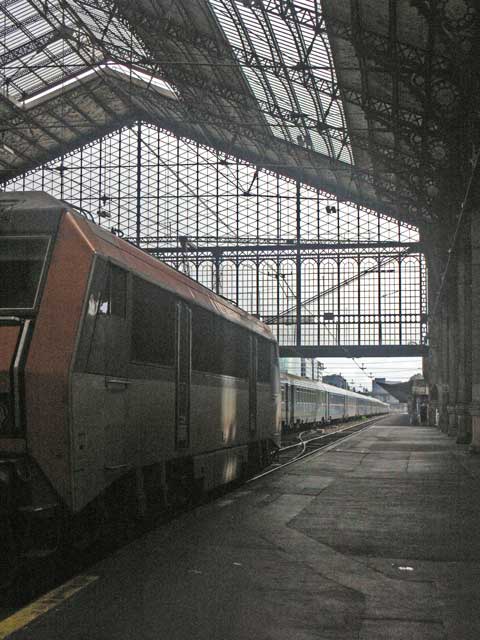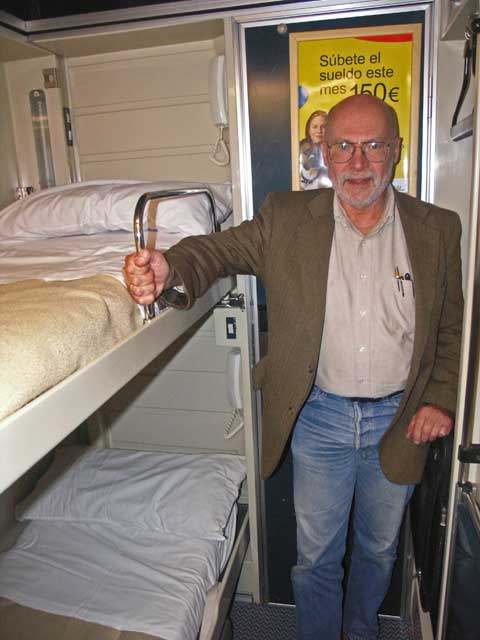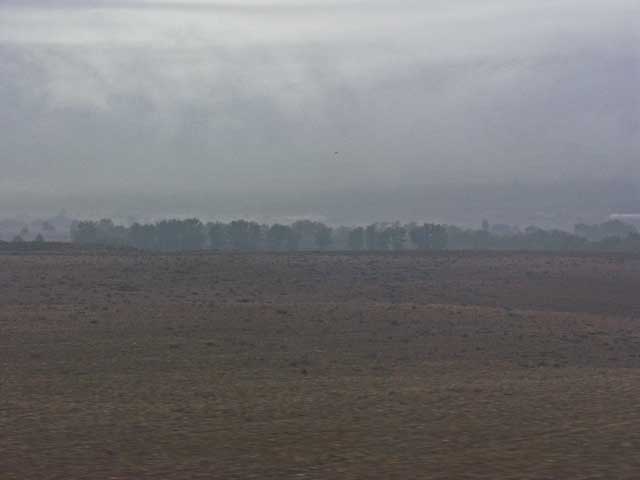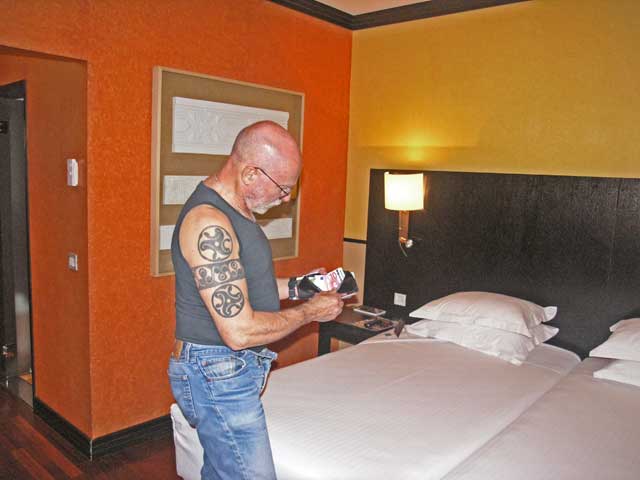
The view from the waiting platform in Austerlitz Station. This was the view from where we were sitting. Our train departed from a platform to the far left of the station from this view.

Sitting in a somewhat dreary waiting room, Jonathan has started his travel diary. Lacking anything else to do, I’ve started also.
This year’s trip is to southern Spain, Andalusia specifically. I’ve been interested in the area since reading a piece of “historical fiction”/alternate universe fantasy by Guy Gavriel Kay, The Lions of al-Rassan. The unique history of the area, i.e. its heritage as the only part of Europe that experienced Islamic rule, has had a major impact on the art, architecture and culture. The Moors ruled in Spain (over varying amounts of geography) from 711, when they first crossed the straits of Gibraltar from Northern Africa to 1492, when the last Moorish stronghold of Granada fell to their Catholic majesties, Ferdinand and Isabella.
During that time, Islamic culture from Baghdad to Damascus, Cairo to Córdoba carried the torch of civilization while Europe struggled through the Dark Ages. In no small part is the Islamic rule of Spain responsible for the transmission and expansion of the works of the classical philosophers. Many of these works were translated in to Arabic from Greek, and later into Hebrew and Latin, for the libraries and universities of Moorish Spain, and from these libraries, the works were disseminated throughout Europe.
As with our previous two journeys (Chile 2004 and Olympic Nat’l Park 2005), the centerpiece of this adventure is a Country Walkers tour, this one titled Spain: From Granada to Seville.
We left the house just before 5am on the 18th of October. Again we used Super Shuttle to get to the airport to catch an 8:05am flight from LAX to Newark. We weren’t able to get upgraded on this leg of the flight, but were upgraded on the more important leg – Newark to Paris (CDG). While in the Newark airport, we ate lunch at the Garden State Diner. Jonathan has eaten there in transit a number of times, complimenting the cheesecake. We didn’t have any this time and the meal was rather pedestrian.
The flight to Paris was on a Boeing 777. As mentioned before, we were able to upgrade on this leg. The seats were rather high-tech allowing an almost complete recline. The fed us well on the flight but the bacon-mushroom cheeseburger I had earlier had me pretty full-up. Afterwards, I tried out the full recline feature of the seat and managed to get some shut-eye.
We landed in Paris at 0715 local time – it was still quite dark – and unloaded onto busses to the terminal. We went through immigration rapidly and went to reclaim the bag we checked.
This bag we bought at Target with two criteria – it had to be big enough to hold our trekking poles, and the color had to be garish enough to spot easily on a luggage carousel. I must say that the “raspberry” color worked splendidly.
From there we went in search of the train station at the airport and took the train into Paris. We had to change trains once to get to Austerlitz Station. We had a minor adventure as we got off the second train (i.e. the Metro) after one station when we should have gone three. We figured this out fairly quickly and got back onto the Metro to the train station at about 1000.
Our train (#409) to Madrid wasn’t scheduled to leave until 1945, so we cooled our heels in the station. We’d alternate one watch the baggage while the other explored. Jonathan went further a field than I locating an ATM, a restroom, and restaurants to have lunch. We took advantage of the restaurants, dragging our bags with us, with a quick stop at the ATM for some euros. After lunch it was back to the waiting at the station, where I think we both snoozed a bit but spent most of the time reading and watching our train work its way up the departure board.
When the track was announced, we dragged the bags to the train and located our berth – coach 69, seats 41 & 45. This was a two seat roomette with two fold-down, bunked beds. The staff of the restaurant car came by to take our reservations – two seatings one at 8 pm and the other at 10 pm – so we chose the 8 pm seating. The food on the train wasn’t memorable, although there is a certain romance to the experience that was very enjoyable.

The view from the waiting platform in Austerlitz Station. This was the view from where we were sitting. Our train departed from a platform to the far left of the station from this view.

Jonathan in our berth with the beds down.
We paid up shortly before 10 pm to give the wait staff time to reset for the 10 pm seating and returned to our room. The attendant lowered the beds, Jonathan claimed the lower bunk, leaving me the upper bunk. I didn’t sleep too well on the train. I woke up a bit after midnight and tossed and turned for a couple of hours. Eventually I climbed down and sat at the end of Jonathan’s bunk wrapped in a blanket, looking out the window to watch what I could of the “scenery” at night. Our car was just behind the club car which had its lights on all night casting a glow on the side of the rail bed. This provided enough light to watch the world (as far as that light reached) go by.
The train took us through the Pyrenees mountains and there were numerous short tunnels as the train twisted onour way. I could make out the dark silhouettes of the mountains against a less-dark cloudy sky that was reflecting enough light to provide that distinction. Eventually the train route became less twisty and I was drowsy enough that I climbed back up into my bunk and got a couple hours of sleep that Jonathan interrupted to get me up to go to breakfast at 7 am. The problem I was having sleeping was two-fold – one, it was too warm in the room, and two, there was too much sensory stimulation, e.g. the motion of the train with its sways and lurches and the sound of the wheels going around curves. All-in-all, I was fairly grumpy when Jonathan woke me up.
We reached Chamartin Station a bit after 9 in the morning. Jonathan pronounced it more like a train station than Austerlitz, and we again proceeded to wait until out train was to leave seven hours later. We again took turns wandering around the station on what turned out to be a rainy day. The Chamartin station appears to have less around it in the way of businesses than Austerlitz, and the rain dampened any residual enthusiasm for exporing that survived two somewhat sleep-deprived evenings. So we sat and did what we did the day before – watch for our train as it climbed the departure board, and people watched.
The restaurant in the station opened for lunch at 1300, so we had lunch (with our bags) there. We both ordered the special of the day, and both selected a cream of vegetable soup for an appetizer. The station was somewhat cool, and the humidity made it penetrating. A bowl of hot soup was just the ticket to warm us up.
Afterwards we went to the customer service desk to make the remainder of our train reservations. The Paris-to-Madrid and Madrid-to-Granada trains I had reserved online through RailEurope and received paper tickets in the mail. Our trains from Sevilla-to-Córdoba, Córdoba-to-Toledo, and Toledo-to-Madrid hadn’t been reserved yet. So we got some help from an English speaking attendant to direct us to the proper line, where I used the calendar on which I planned the trip to communicate with the ticket agent.
It’s been interesting communicating. I don’t have an ear for language, but Jonathan has a much better read on vocabulary and sounds and has been able to communicate much more effectively than I. I’d surmise that his fluency with French helps him a lot with Spanish.
We sat down again – we both snoozed a bit – while watching our bags for another two hours. Finally our train was called and we found our coach and seats. The train took us south, essentially under Madrid stopping at Atocha Station, which was the site of the terrorist attacks a few years ago. It’s a very modern station that we’ll be going through when we return.
The train, as most trains do, takes you through urban industrial areas before it reaches countryside that’s more pleasing to the eye. Our departure of 1647 was delayed 20 minutes, but we did reach less populated areas before darkness fell.
The clouds occasionally produced rain as the train took us across the central plains of Spain. Feel free to conjure up scenes from My Fair Lady at this point – I certainly did as the twilight fell. I also dozed frequently as the light faded. At Linares-Baeza, they changed the electric locomotive for a diesel version – I described it as the New Haven of the Spanish railway as the same activities were taken on Amtrak trains in the Northeast Corridor before that line was electrified all the way to Boston. From there it was another 2 1/2 hours to Granada, going through another set of mountains to reach the plateau that was the last outpost of Moorish rule in Europe.

The view out the window of the train from Madrid to Granada.

Jonathan in our room at the AC Palacio de Santa Paula, examining his euros. He described the money as "Monopoly money" because it is much more colorful than US notes - and that it seemed a bit unreal spending them.
We took a taxi from the station to the hotel, the AC Palacio de Santa Paula, which wasn’t far. At check-in we asked about the hotel restaurant and found they were minutes from closing (being shortly before 2330). The clerk suggested we leave our bags at the front desk and we go directly to the restaurant – so we did.
The restaurant was located on the courtyard of the convent that had been converted into the hotel. We opted to sit inside, but the courtyard was well lit and appealing to the eye. We had an exceptionally good meal there. I started off with a melon soup with lobster that was light and fresh and not overly sweet. In addition it had a nice aromatic character provided by mint. I followed that with roast suckling pig topped with a tasty mix of vegetables. Jonathan’s appetizer was smoked salmon while his main course was venison. He described it as “just yummy.” Rather than dessert, we opted for some port, but the server suggested a sherry that was as dark as coffee. The amount he poured was generous and Jonathan didn’t finish his, it was so sweet.
When we returned to the front desk for our bags, it was approaching 0100, and we found that they had sent them up to our room already. So we went up and after figuring out how to turn on the lights (there’s a slot where you insert your room key) Jonathan took a shower while I collapsed into my first stationary bed in 72 hours. I slept quite soundly.
